As the demand for concealed carry handguns has boomed, so, too, has the number of new self-defense ammunition offerings, with the ammunition makers all tending to make the same claims about their self-defense loads. Maximum expansion. Great accuracy. Will not over-penetrate. And, of course, meets FBI standards for self-defense ammunition.
All of which sounds good. But how does the stuff actually perform?
I had the chance to do some testing recently with two new self-defense rounds made by Federal Premium Ammunition: Syntech Defense in 9mm and .45 Auto; and, Train + Protect, also in 9MM and .45 Auto.
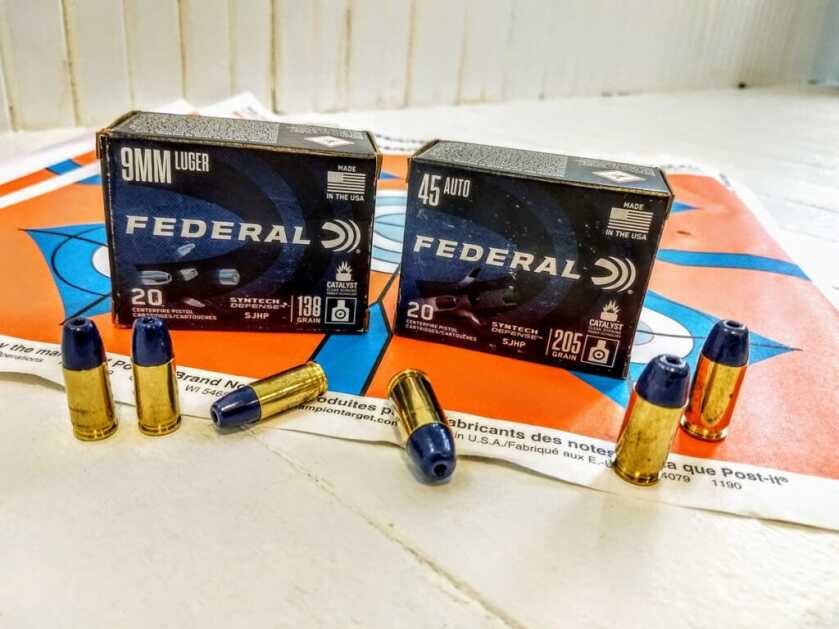

The initial testing took place at Federal’s main facility in Anoka, Minnesota, where I fired the rounds into blocks of 10-percent ballistic gel. The testing encompassed firing into bare gelatin; gelatin covered with various layers of cloth; and, gelatin fronted with two pieces of half-inch drywall.
I measured the lengths of penetration of the bullets into the gel blocks, then dug out the bullets to measure expansion and weight retention.
The gel block shooting took place in an underground testing tunnel of Federal’s, and the gel blocks were set at a distance of 10 feet. For each testing medium (bare gel, cloth-covered, etc.), I fired three to four rounds of each caliber.
For the heavy clothing test, the front of a gel block was covered in three layers: tee shirt material; a more felt-like layer; and a quilted layer to replicate a jacket.

The Drywall testing was done by placing two .5-inch sheets of drywall approximately four-inches apart and firing through the two sheets from ten feet. A gel block sat 14-inches away from the rear of the last drywall sheet.

Later, at my home range, I shot the rounds for accuracy.
Here’s what I discovered:
The Syntech Defense rounds are a spin-off of Federal’s successful American Eagle Syntech rounds introduced a few years ago. Initially made as range ammunition, Syntech projectiles are lead, but are encapsulated in a red polymer jacket. That way, there’s no metal-to-metal contact, which reduces fouling and barrel wear.
Syntech Defense projectiles sport a blue polymer coating to differentiate them from the Syntech range rounds. For shooting the Syntech 9MM, I used a Ruger Security 9 with a 4-inch barrel; for the Syntech 45 AUTO, I used a Glock 21 Gen 4.
The Syntech Defense rounds are designed to come apart. That is, the front half of the bullet breaks into three separate pieces that go forward, while the larger, intact base holds together and follows. So, a Syntech Defense bullet creates four separate wound channels of varying sizes.
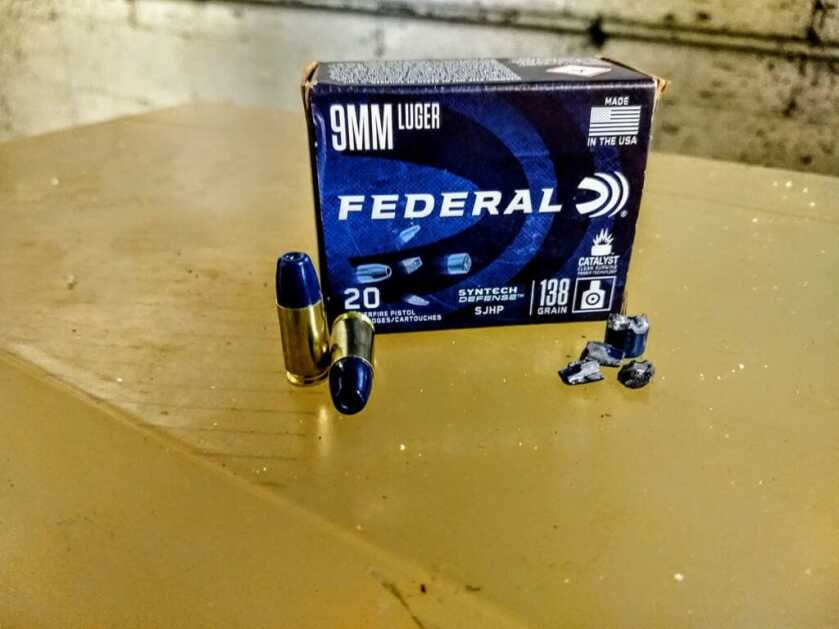
For the 9MM Syntech Defense in bare gel, the average depth of penetration of the base was 15.25”. On average, the three front pieces went forward another 7.5.”
Weight retention, as measured with an RCBS Rangemaster 2000 Electronic Scale, averaged right at 136-grains versus the original 138 grains when weighing all four pieces of the bullet.
For the 9MM in cloth-covered gel, the average depth of penetration of the base was 15.75.” On average, the three front pieces traveled another 8.0.”
Weight retention: 135.7 grains.
For the 9mm fired through drywall sheets, the average depth of penetration of the base was 16.25.” On average, the three front pieces traveled an additional 7.0.”
Weight retention: 137.5 grains.
For the Syntech 45 Auto in bare gel, the average depth of penetration of the base was 15.25.” The three front pieces traveled, on average, another 8.5.”
Weight retention: 203.7 grains versus the original 205 grains.

For the 45 Auto cloth-covered gel, the average depth of penetration of the base was 15.0” The three front pieced traveled, on average, another 8.75.”
Weight retention: 205 grains. No loss.
For the 45 Auto fired through drywall sheets average depth of penetration of the base was 13.5.” The three front pieces, on average, traveled ano0ther 8.75.”
Weight retention: 204 grains.
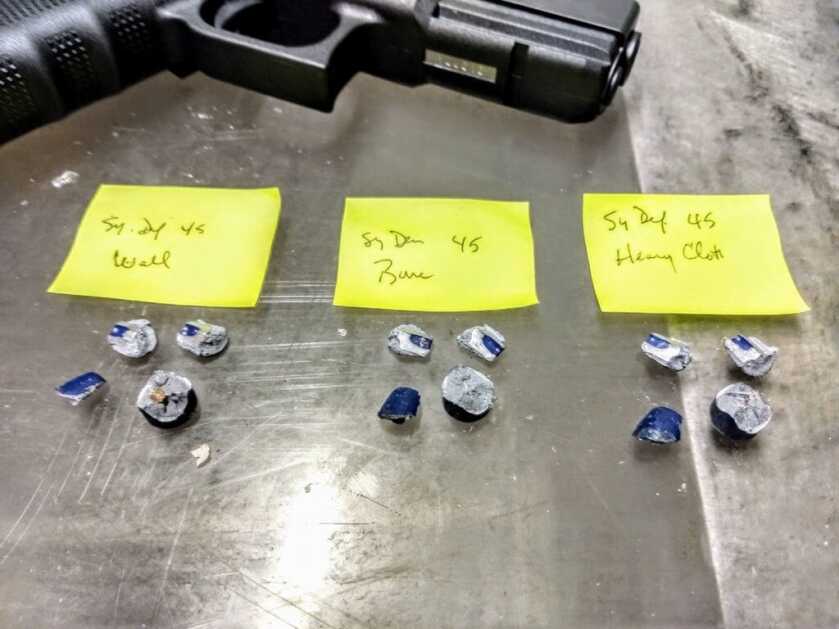
Of Note: The three front pieces did not travel in straight lines. At the point where they split from the base, the three smaller pieces angled away to cut a “V” shape into the gel.
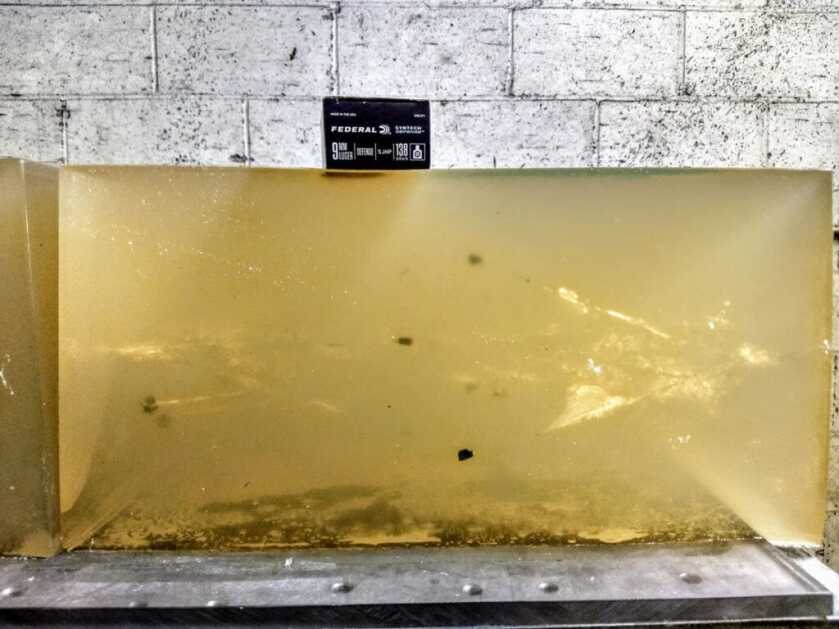
Accuracy
At my home range, accuracy for both rounds were very good. I used a CZ-USA sub-compact Rami pistol for the 9MM rounds and a Remington R1 Enhanced 1911 for the 45 AUTO rounds. Average five-shot groups, fired at 7 yards offhand, came in at 1.0 to 1.25” for both calibers.
At ten yards, offhand, the 9MM Syntech Defense pegged groups between 1.15” and 1.55”, while the Syntech Defense 45 AUTO made groups of 1.5” to 1.90.”
These groups, by the way, were fired at an outdoor range, with the temperature around 30 degrees Fahrenheit and with light snow falling. Without the heavy coat and if the shooter (me) had been warmer? I’d expect tighter groups.
Summary
The break-up design of the Syntech Defense bullets is intriguing, and the rounds perform as advertised. Yet, I have to wonder about their self-defense effectiveness, especially in the 9MM load.
The three separate pieces of the front of the bullets certainly went some distances, in a nice three-pronged pattern. In 9MM, though, those pieces are quite small and light. My RCBS Rangemaster 2000 scale measured the 9MM front pieces at just 20 grains apiece—half of what a .22 LR bullet weighs.
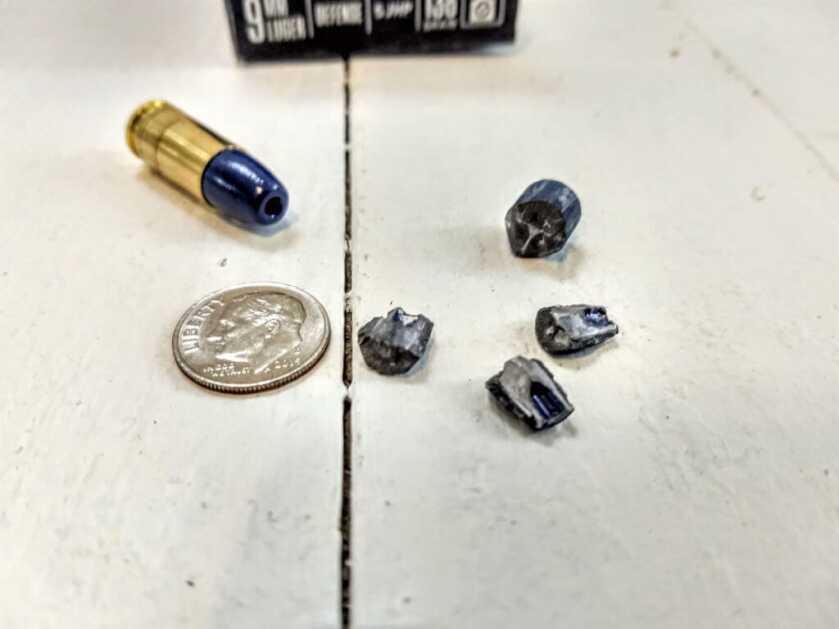
At 20-grains each, that also means the base of the bullet only weighs in at approximately 78-grains (The solid 9MM bullet starts at 138 grains minus 60 grains for front pieces equals base weight of 78 grains.) Not exactly what most self-defense experts I know would rate as a “man-stopping” projectile.
Would these three pieces potentially create more damage to tissue and vessels? Sure. But I don’t believe they’d be more effective than a single, heavy projectile, plowing through tissues, vessels, and bone. In fact, I wonder if the 9MM front pieces would penetrate bone.
The Syntech Defense .45 AUTO round looks to be a more effective self-defense option. The three separate pieces of the 45 AUTO weigh-in from 30- to 36-grains and, at the base, measured approximately .22” wide and .36” long. Large enough to do some real damage, I believe, the whole still leaving a base that weighs about 105 grains (figuring three pieces at around 33 grains apiece.)
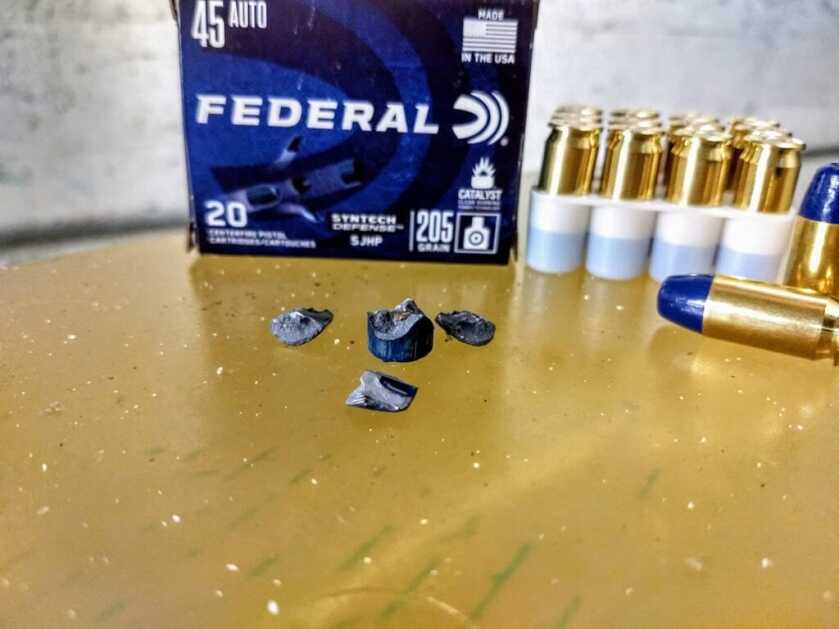
Me, I’d pass on the 9MM Syntech Defense for daily carry but would consider the .45 AUTO variety. Some feedback from law enforcement agencies that are or have used either caliber of the ammunition would be a big help, too. Dropping a few deer and or wild hogs with the .45 AUTO rounds could be insightful, too, along with retrieved bases and pieces.
My time and testing with the Train + Protect ammunition was much reduced compared to the Syntech Defense. The Train + Protect ammunition was not on my original testing schedule but became available once I got to the Federal facility. I squeezed it in at the end, but the testing was, admittedly, limited, as I only tried out the 230-grain 45 AUTO load.

In general, the 45 AUTO bullets penetrated 18-plus inches of gel. When shot first through the two sheets of drywall, I had two of these bullets drive through 22-inches of gel. The FBI and law enforcement agencies, in general, would consider that over-penetration, the kind that leads to bystanders being wounded or worse. The FBI wants handgun ammunition that penetrates, ideally, between 14- to 16-inches, and anything over 18-inches is considered over-penetration.
And while the hollow point openings widened slightly in all testing, there was essentially no expansion.
No weight loss, either. In fact, the hollow point tended to grab up drywall, cloth, and gel and the fired bullets weighed three to five grains heavier than the original 230-grain bullet.
However, there was one exception. In the dozen or so Train + Protect rounds in 45 AUTO that I fired, one bullet did present decent expansion in bare gel, growing to .620 inches. The expansion also produces several sharp, cutting edges as the front of the bullet peeled back. It also only penetrated 15-inches of gel. If the ammunition could provide more of this level of expansion and penetration? I’d consider it a viable carry round.
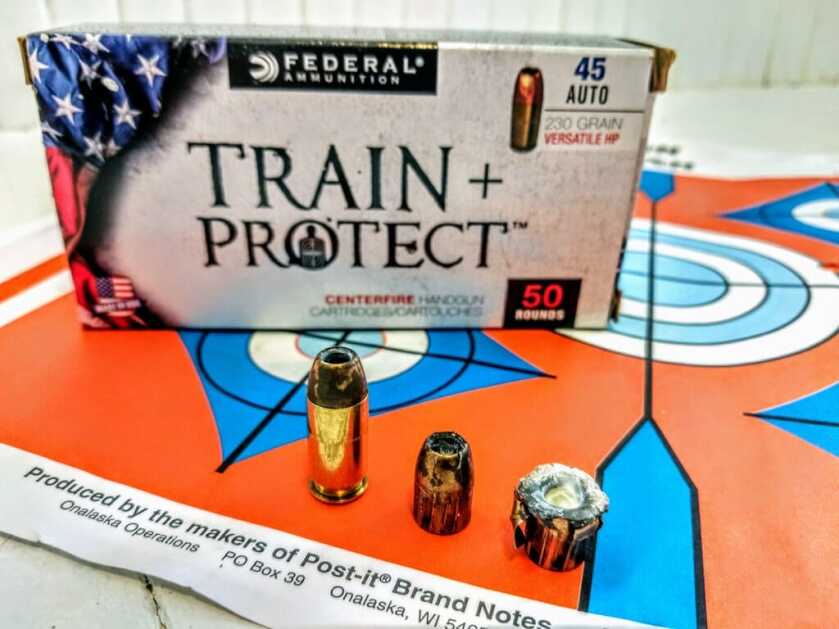
For accuracy testing, I did shoot both the 9MM and 45 AUTO Train + Protect rounds at seven and ten yards offhand. The 9MM shot a .94” group at ten yards and the 45 AUTO placed five rounds at ten yards offhand anywhere from 1.11” to 1.68.” Again, cold and snow no doubt got in the way of better accuracy.
The Train + Protect rounds are reasonably priced. An online search found the 9MM selling for approximately .48 cents per round, the 45 AUTO at anywhere from .44 cents a round for 100 rounds to .50 cents per round for a box of 50. That’s approximately 30- to 40 percent (or more) under the cost of many self-defense rounds. And it would represent a pretty good deal–if the engineers at Federal could get the bullets to expand like that one of mine did on an every-shot basis.

I find the some of the wording here confusing. “..depth of penetration of the base was 15.0” The three front pieced traveled, on average, another 8.75.” This makes it sound as if the base traveled 15″ and the pieces went an additional 8.75”.
From the photos, this is clearly not the case. Probably should have said “the pieces went only 8.75”
The fragmented portion of the Syntech projectiles penetrate only between 7-8 inches. When impacting a large felon, especially from other than straight-on, those fragmented projectiles will be of zero value. Very poor form from a companyAs respected as Federal.
Great review. I work at a big box gun counter and have seen this ammo on the shelf. I appreciate the info and will use it to help customers decide on the ammo they wish to use for their self defense.